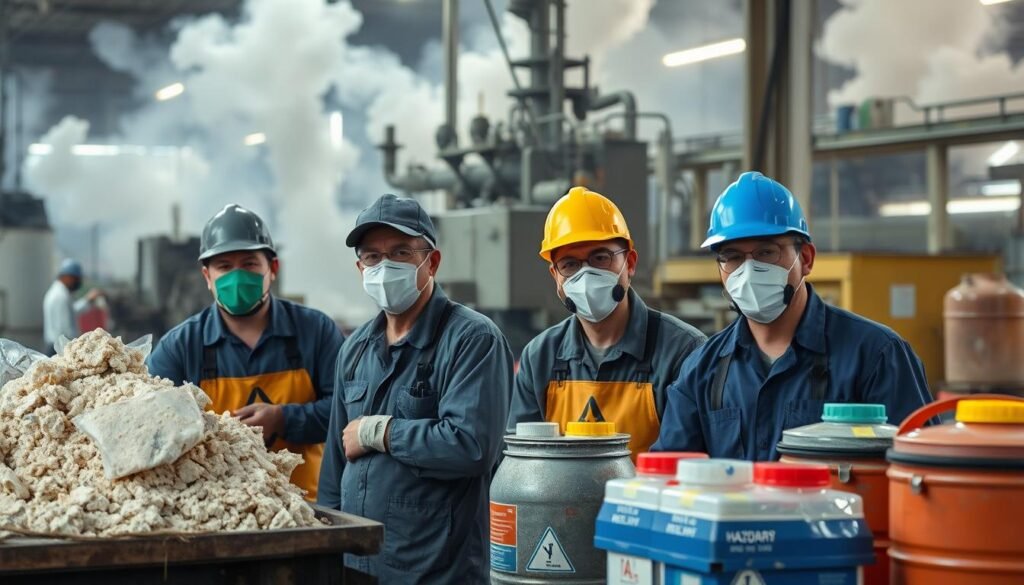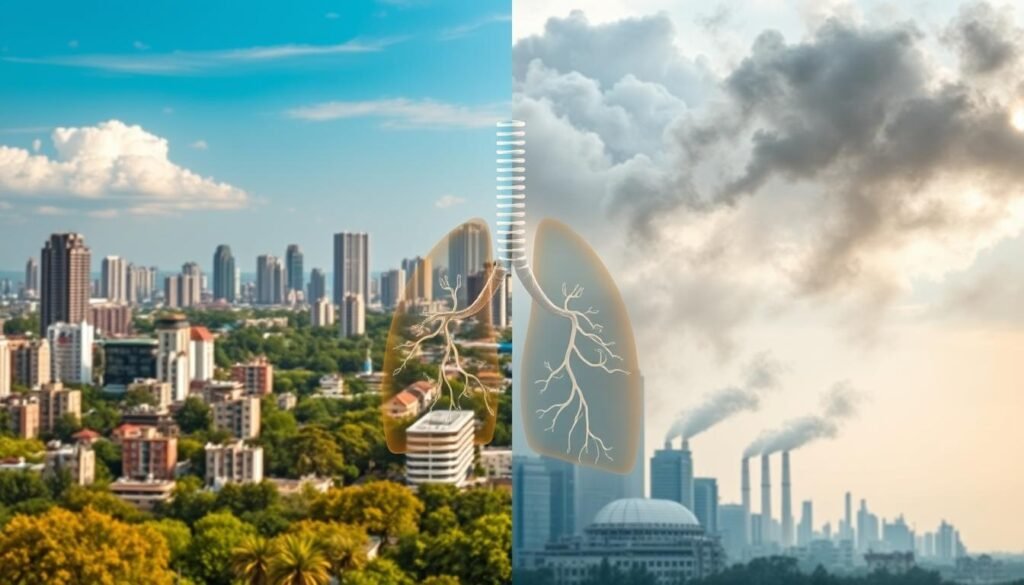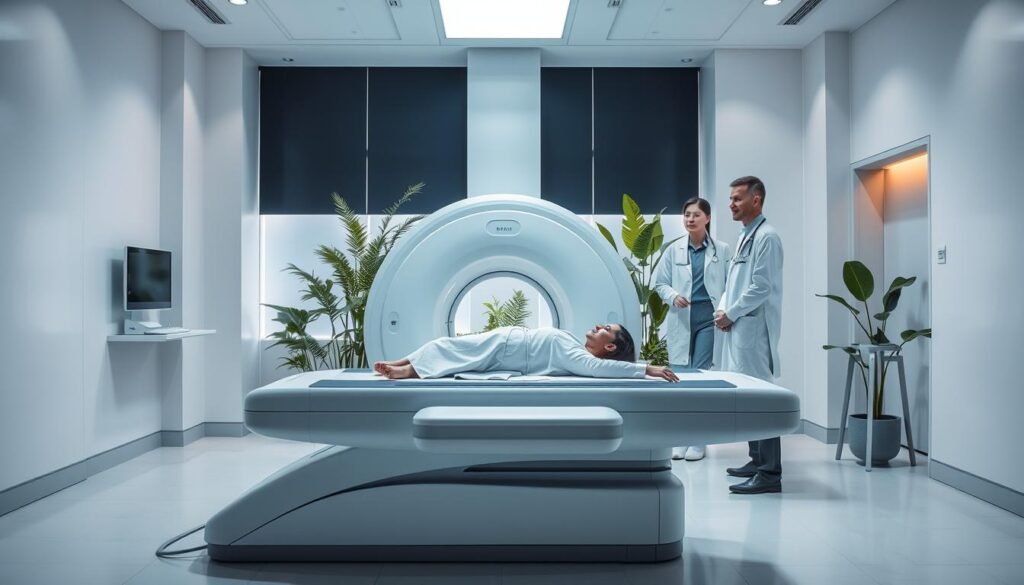Did you know about 80% of lung cancer cases come from smoking? This fact shows how crucial prevention strategies are. It’s vital for everyone to learn how to lessen lung cancer risks. This guide will give you a deep look into methods that can help reduce the risk.
Throughout this guide, you’ll learn about factors that affect lung cancer risk. We’ll talk about the critical need to avoid smoking and secondhand smoke. You’ll also learn about risks from things like radon. Plus, we’ll discuss how living healthy and choosing the right foods can help prevent cancer. Sometimes, lung cancers don’t have clear risk factors. But, by being proactive, you can work towards a healthier future. For deeper strategies, check out this prevention guide.
Key Takeaways
- Quitting smoking can significantly lower lung cancer risk.
- Testing homes for radon is crucial to minimize lung cancer risk.
- A diet rich in fruits and vegetables may contribute to lung health.
- High doses of certain vitamins do not reduce lung cancer risk in smokers.
- Regular physical activity can aid in lowering the risk.
- Screening for lung cancer is vital for early detection, especially among high-risk individuals.
- Being aware of harmful substances and implementing safety measures is essential for prevention.
Understanding Lung Cancer Risks
Lung cancer is the top cause of cancer deaths worldwide. This highlights the importance of knowing the risks. Smoking is the main reason behind about 80% of lung cancer deaths. The longer and more you smoke, the greater your risk.
Quitting smoking can greatly lower your chance of lung cancer. This is true even for long-time smokers. Note that heavy smokers mostly get small cell lung cancer. Yet, non-small cell lung cancer affects many more people.
Many factors increase the risk of lung cancer. These include secondhand smoke, past radiation therapy, radon gas, and certain chemicals. Having lung cancer in your family also ups your risk. Here are key risk factors:
| Risk Factor | Impact |
|---|---|
| Smoking | Increases risk significantly; 90% of cases linked to tobacco use |
| Secondhand Smoke | Increases lung cancer risk in non-smokers |
| Radon Exposure | Second leading cause of lung cancer in homes |
| Previous Radiation Therapy | Higher risk for lung cancer in patients treated for other cancers |
| Asbestos Exposure | Significantly elevates risk for certain occupations |
| Family History | Increases likelihood of developing lung cancer. |
It’s crucial to be proactive about these risks. The best strategies include not smoking or quitting if you do. Avoid secondhand smoke and test your home for radon. Also, eat plenty of fruits and vegetables and stay active to lower your risk.
Importance of Not Smoking
Smoking greatly increases health risks linked to tobacco. It’s the top reason for lung cancer. Quitting smoking brings huge health benefits, like lowering the risk of death from smoking-related diseases. If people quit before 40, they can cut these disease risks by about 90%.
People who quit smoking might live up to 10 years longer than those who keep smoking. Quitting also lowers the risk of other cancers, including those of the stomach, liver, and colon, as well as acute myeloid leukemia.
Stopping smoking has quick benefits besides health. It saves money spent on tobacco. Quitting improves taste, smell, physical fitness, and looks. It also reduces the risk of heart issues and chronic lung problems like COPD and lung infections.
Research shows even small steps towards quitting make a big difference. Cutting down from 20 to 15 cigarettes a day lowers lung cancer risk by 20%. Quitting smoking is the best way to fight tobacco-related health issues and improve one’s health future.
How to Reduce Risk of Lung Cancer
There are effective ways to lower your chance of getting lung cancer. It’s key to stop smoking and keep areas smoke-free. Smoking is behind nearly 90% of lung cancer cases. So, stopping smoking is the best move to cut your lung cancer risk.
The Role of Quitting Smoking
Stopping smoking greatly betters lung health. It’s vital for lessening the chance of lung cancer. Smoking is linked to 87% of lung cancer deaths in the U.S. But, those who quit can gradually lower their risk. After 20 to 25 years without smoking, their risk can become the same as non-smokers. This fact gives people hope and a push towards a healthier life.
Benefits of a Smoke-Free Environment
A smoke-free space helps smokers and non-smokers alike. It’s crucial to avoid secondhand smoke since it causes over 7,000 lung cancer deaths each year among non-smokers. Smoke-free policies in public places promote healthy living. They also make it less normal to use tobacco. This aids in the fight against lung cancer.
Recognizing the Dangers of Secondhand Smoke
Secondhand smoke is very harmful, especially for people who don’t smoke. Researchers have found that non-smokers around smoke have a higher chance of getting lung cancer. This finding proves why we need smoke-free places to keep everyone safe.
Every year, about 19,000 people in the U.S. die because of secondhand smoke. Out of these, more than 7,300 deaths are non-smokers dying from lung cancer. Tobacco smoke has over 7,000 chemicals and nearly 70 of them can cause cancer. We need to do what we can to avoid coming into contact with it.
Kids are really vulnerable to secondhand smoke. It can cause serious problems like sudden infant death syndrome (SIDS), breathing infections, and more asthma attacks. Even more, it can lead to coughing and wheezing, which can cause long-term health issues. Babies whose moms are around smoke when pregnant are at risk for childhood cancers too.
At work, secondhand smoke causes big economic losses, totaling $7.2 billion in 2017. It’s important for workplaces to be smoke-free. This helps protect employees from being exposed to harmful smoke.
Many cities and states have banned smoking in public spots. These bans protect non-smokers and improve the health of our communities. It’s important to be aware and take action against the dangers of being around smoke.
For more information about the health risks and how to avoid secondhand smoke, check out the CDC.
Testing and Reducing Radon Levels
Radon is a big environmental risk for lung cancer. This radioactive gas comes from uranium breaking down in soil, rock, and water. It can build up in homes, especially basements, and affect your health.
What is Radon?
Radon is a gas you can’t see, smell, or taste, making it very sneaky. The U.S. Environmental Protection Agency (EPA) says radon is the second main cause of lung cancer in the U.S. About 21,000 people die from it each year. Smokers face an even bigger risk from radon.
How to Test for Radon in Your Home
You can check radon levels yourself with test kits or get a pro to do it. The EPA says to test every two years, especially after making changes to your home. High radon levels, above 4 picocuries per liter (pCi/L), need action to bring them down.
Ways to lower radon include:
- Putting in a radon reduction system, costing $800 to $2,500.
- Boosting airflow by opening windows and using fans.
- Sealing floor and wall cracks to stop radon from getting in.
- Asking local experts for more radon management tips.
Occupational Hazards and Lung Cancer
It’s important to understand the link between job hazards and lung cancer. This awareness helps improve safety at work. Many jobs expose workers to dangerous substances, increasing their lung cancer risk. Recognizing these hazards is the first step in creating safer workspaces.
Common Carcinogens in the Workplace
Several substances in the workplace are known to harm lung health. These include:
- Asbestos – Often found in construction, it’s linked to lung cancer and mesothelioma.
- Arsenic – Used in mining and manufacturing, it’s also tied to a higher risk of lung cancer.
- Beryllium – In aerospace and nuclear jobs, it can increase lung cancer risk.
- Cadmium – Found in battery making and metal work, it’s a known carcinogen.
- Diesel exhaust – Workers in transportation face exposure to these harmful fumes.
- Silica – In mining and construction, breathing in silica dust poses lung cancer risks.
Safety Measures to Reduce Exposure
Key safety practices can lower the risk from workplace hazards. Companies must focus on:
- Regular Training – Education on carcinogens and safety is crucial for all workers.
- Personal Protective Equipment (PPE) – Using proper PPE, like masks, protects workers.
- Monitoring and Evaluation – Regular checks help maintain safe air quality at work.
- Ventilation Improvements – Better air flow can decrease harmful substance levels.
- Health Surveillance – Early health checks can spot job-related health issues sooner.

By tackling workplace hazards, companies can lower lung cancer risks. Staying informed and taking action makes workplaces safer and healthier for everyone.
Importance of a Healthy Diet and Regular Exercise
Having a balanced diet and regular exercise helps a lot with your health. This is especially true for preventing lung cancer. Studies show that what you eat and how much you move can affect your cancer risk. To lower your chances of getting lung cancer, eat right and stay active. This improves your health if you’re recovering from cancer too.
Foods That May Protect Against Lung Cancer
Some foods can defend against lung cancer. Your diet should include:
- Fruits and vegetables full of vitamins and antioxidants
- Whole grains that provide nutrients and fiber
- Legumes, which are rich in protein and low in fat
- Healthy fats found in avocados, nuts, and olive oil
- Staying away from processed and red meats, and sugary drinks
Keeping a healthy weight is important too. In the US, over 18% of cancer cases are linked to being overweight and eating poorly. Eating well helps a lot with lung cancer prevention.
The Impact of Physical Activity on Lung Health
Being active is great for your health and your lungs. Adults should try for:
- 150-300 minutes of moderate exercise or 75-150 minutes of something more intense every week
Kids need about 60 minutes of activity each day. Exercise fights off tiredness from cancer treatments. It also keeps your immune system strong. Getting help to live a healthier life can make a big difference.
Eating right and staying active can lower your lung cancer risk. Research by Dr. Marisa Bittoni at The Ohio State University supports this. Choosing a healthy lifestyle is a key way to fight lung cancer.
The Connection Between Air Pollution and Lung Cancer
Lung cancer is the top cause of cancer deaths for both men and women in the US. Air pollution plays a big role in this fact. It’s known as a major risk factor for lung cancer. Research shows outside air pollutants, especially from cars, coal plants, and industries, can cause lung cancer.
Particle pollution is very harmful to our health. Bigger particles irritate the eyes, nose, and throat. Smaller particles go deep into our lungs and can even get into our blood, causing more damage. In 2013, a group called the World Health Organization’s International Agency for Research on Cancer said particulate matter causes cancer. This made the link to lung cancer clear.

Air pollution in the U.S. has gone down thanks to the Clean Air Act. But even low levels of air pollution can lead to lung cancer. People like kids, older people, and those with health problems are at greater risk. Knowing about air quality and staying inside when pollution is high is important for health.
Some politicians question the rules set by the Environmental Protection Agency. But groups like the American Lung Association still back the Clean Air Act to cut down on bad emissions. Studies for over 40 years show air pollution relates to more lung cancer cases. Research shows a 30 to 50% higher lung cancer risk from being exposed to fine particles.
Yet, we might not fully understand air pollution’s role in causing lung cancer in the U.S. Better research methods to measure how much pollution people are exposed to could help. This could show us more about cancer risks from air pollution.
Genetics and Family History in Lung Cancer Risk
It’s crucial to understand how genetics and family history relate to lung cancer risk. If you have a family history of lung cancer, you’re at higher risk. This risk comes from both genetic factors and common environmental exposures, like secondhand smoke.
Genetics play a clear role in lung cancer risk. Certain gene mutations can make people more susceptible. For instance, 60% of those with lung adenocarcinomas have specific mutations in the EGFR and KRAS genes. Having a first-degree relative with lung cancer raises your risk by 1.51 times. This shows why knowing your family’s health history is so important.
Research shows a stronger risk if your siblings have lung cancer, with an odds ratio of 1.82. Even people who have never smoked can have a 1.25 odds ratio if they have a family history. This highlights the genetic factor in assessing lung cancer risk.
Lifestyle and environmental factors are also key. By evaluating genetics and family history, you can be proactive. This enables early detection and preventive actions against lung cancer.
Importance of Early Detection Screening
Screening early can hugely improve lung cancer patients’ survival rates. Lung cancer is the second most common cancer and leads in deaths. Early checks can cut down death rates, especially for those at high risk.
Screening Methods for Lung Cancer
Low-dose computed tomography (LDCT) scans are key in lung cancer checks. They are best for people 50 to 80 who smoked a lot. This group includes current smokers or those who quit in the last 15 years, having smoked 20 pack-years.
LDCT scans can spot early signs of cancer. Studies show they lower lung cancer death risk by 20-25% compared to x-rays. But, they are not right for everyone. Sometimes, they show non-cancer spots, making more tests needed.
Screenings work best at expert places. Here, pros can do follow-ups right. Sadly, not many eligible folks get screened. Over 36% live too far from places that do LDCT scans.
To sum up, good early screening can save lives. It helps catch lung cancer early, raising chances of beating this tough disease.
| Screening Criteria | Details |
|---|---|
| Age Range | 50 to 80 years |
| Smoking History | 20 pack-year or more |
| Time Since Quitting | Quit within the last 15 years |
| Recommended Method | Yearly LDCT scans |
| Morbidity Reduction | 20-25% lower risk of dying from lung cancer compared to chest x-rays |

Conclusion
Lowering lung cancer risk is crucial for creating healthier communities. Proactive steps are key. This includes stopping smoking and avoiding secondhand smoke.
Since lung cancer is a major cause of death, knowing the risks and catching it early is vital. Lung cancer screenings are especially important for those at high risk. They can lower lung cancer deaths by 20%.
Although survival rates have gone up by nearly 26% to 28.4%, screening is still underused. Rhode Island is leading with a 28.6% screening rate. Everyone’s effort is needed to fight lung cancer.
By making personal health choices and pushing for community-wide actions, we can fight lung cancer together. Let’s aim for a future with fewer cases by living healthier and getting checked regularly.